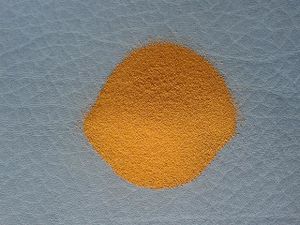Difference between revisions of "Vanadium pentoxide"
| (One intermediate revision by the same user not shown) | |||
| Line 57: | Line 57: | ||
| HenryConstant = | | HenryConstant = | ||
| LogP = | | LogP = | ||
| − | | MolarMass = | + | | MolarMass = 181.88 g/mol |
| MeltingPt = | | MeltingPt = | ||
| MeltingPtC = 690 | | MeltingPtC = 690 | ||
| Line 115: | Line 115: | ||
Vanadium pentoxide will yield oxygen and turns into oxides of lower states and finally the pure metal when heated at high temperature. | Vanadium pentoxide will yield oxygen and turns into oxides of lower states and finally the pure metal when heated at high temperature. | ||
| − | :V<sub>2</sub>O<sub>5</sub> → VO<sub>2</sub> → V<sub>2</sub>O<sub>3</sub> → VO → V | + | : V<sub>2</sub>O<sub>5</sub> → VO<sub>2</sub> → V<sub>2</sub>O<sub>3</sub> → VO → V |
The reaction is reversible. | The reaction is reversible. | ||
Vanadium pentoxide will not be reduced to its respective salts if reacted with a strong acid, instead it will generate oxovanadium cations: | Vanadium pentoxide will not be reduced to its respective salts if reacted with a strong acid, instead it will generate oxovanadium cations: | ||
| − | :V<sub>2</sub>O<sub>5</sub> + 6 HCl + | + | : V<sub>2</sub>O<sub>5</sub> + 6 HCl + 7 H<sub>2</sub>O → 2 [VO(H<sub>2</sub>O)<sub>5</sub>]<sup>2+</sup> + 4 Cl<sup>−</sup> + Cl<sub>2</sub> |
| − | :V<sub>2</sub>O<sub>5</sub> + 2 HNO<sub>3</sub> → 2 VO<sub>2</sub>(NO<sub>3</sub>) + H<sub>2</sub>O | + | : V<sub>2</sub>O<sub>5</sub> + 2 HNO<sub>3</sub> → 2 VO<sub>2</sub>(NO<sub>3</sub>) + H<sub>2</sub>O |
Reaction with [[thionyl chloride]] generates vanadium oxychloride: | Reaction with [[thionyl chloride]] generates vanadium oxychloride: | ||
| − | :V<sub>2</sub>O<sub>5</sub> + 3 SOCl<sub>2</sub> → 2 VOCl<sub>3</sub> + 3 SO<sub>2</sub> | + | : V<sub>2</sub>O<sub>5</sub> + 3 SOCl<sub>2</sub> → 2 VOCl<sub>3</sub> + 3 SO<sub>2</sub> |
Solid V<sub>2</sub>O<sub>5</sub> is reduced by [[oxalic acid]], [[carbon monoxide]], and [[sulfur dioxide]] to give [[vanadium(IV) oxide]], VO<sub>2</sub> as a deep-blue solid. | Solid V<sub>2</sub>O<sub>5</sub> is reduced by [[oxalic acid]], [[carbon monoxide]], and [[sulfur dioxide]] to give [[vanadium(IV) oxide]], VO<sub>2</sub> as a deep-blue solid. | ||
| Line 157: | Line 157: | ||
==References== | ==References== | ||
| − | <references /> | + | <references/> |
===Relevant Sciencemadness threads=== | ===Relevant Sciencemadness threads=== | ||
| + | *[http://www.sciencemadness.org/talk/viewthread.php?tid=4995 Vanadium Pentoxide] | ||
*[http://www.sciencemadness.org/talk/viewthread.php?tid=13849 How to convert ferrovanadium (82%) in vanadium pentoxide] | *[http://www.sciencemadness.org/talk/viewthread.php?tid=13849 How to convert ferrovanadium (82%) in vanadium pentoxide] | ||
Latest revision as of 17:37, 5 September 2019
 Lab grade V2O5
| |
| Names | |
|---|---|
| IUPAC name
Divanadium pentaoxide
| |
| Other names
Vanadia
Vanadic anhydride Vanadium(V) oxide | |
| Properties | |
| V2O5 | |
| Molar mass | 181.88 g/mol |
| Appearance | Yellow solid |
| Odor | Odorless |
| Density | 3.357 g/cm3 |
| Melting point | 690 °C (1,274 °F; 963 K) |
| Boiling point | 1,750 °C (3,180 °F; 2,020 K) (decomposition) |
| 0.08 g/100 ml (20 °C) | |
| Solubility | Soluble in conc. acids, alkali Insoluble in organic solvents |
| Vapor pressure | ~0 mmHg |
| Hazards | |
| Safety data sheet | Sigma-Aldrich |
| Flash point | Non-flammable |
| Lethal dose or concentration (LD, LC): | |
| LD50 (Median dose)
|
10 mg/kg (rat, oral) 23 mg/kg (mouse, oral) |
| Related compounds | |
| Related compounds
|
Vanadium oxychloride |
| Except where otherwise noted, data are given for materials in their standard state (at 25 °C [77 °F], 100 kPa). | |
| Infobox references | |
Vanadium(V) oxide also known as vanadium pentoxide or vanadia is the inorganic compound with the formula V2O5. It is one of several oxides of vanadium.
Contents
Properties
Chemical
Vanadium pentoxide will yield oxygen and turns into oxides of lower states and finally the pure metal when heated at high temperature.
- V2O5 → VO2 → V2O3 → VO → V
The reaction is reversible.
Vanadium pentoxide will not be reduced to its respective salts if reacted with a strong acid, instead it will generate oxovanadium cations:
- V2O5 + 6 HCl + 7 H2O → 2 [VO(H2O)5]2+ + 4 Cl− + Cl2
- V2O5 + 2 HNO3 → 2 VO2(NO3) + H2O
Reaction with thionyl chloride generates vanadium oxychloride:
- V2O5 + 3 SOCl2 → 2 VOCl3 + 3 SO2
Solid V2O5 is reduced by oxalic acid, carbon monoxide, and sulfur dioxide to give vanadium(IV) oxide, VO2 as a deep-blue solid.
Sodium metavanadate can be made by reacting vanadium(V) oxide with hot sodium carbonate. This can then be reacted with ammonium chloride to form the less soluble ammonium metavanadate[1].
Physical
Vanadium pentoxide is a brown-yellow compound, slightly soluble in water, where it gives yellow colored solution.
Availability
Vanadium pentoxide is sold by certain ceramic pigment companies. US pigment sells 1 pound at $30, and Seattle Pottery Supply sells it for $24 per pound.
Preparation
Thermal decomposition of ammonium metavanadate at 200 °C will give pure vanadium pentoxide:
- 2 NH4VO3 → V2O5 + 2 NH3 + H2O
Projects
- Vanadium oxides
- Sulfur trioxide and sulfuric acid generation
- Maleic and phthalic anhydride synthesis
- Vanadium redox battery
Handling
Safety
Vanadium pentoxide exhibits modest toxicity to humans, with an LD50 of about 470 mg/kg. The greater hazard is with inhalation of the dust, where the LD50 ranges from 4-11 mg/kg for a 2 week exposure.
Storage
Vanadium pentoxide should be stored in closed containers, away from any acidic vapors.
Disposal
Vanadium pentoxide should not be released in the environment in large quantities. Recycle it or take it to waste disposal centers.